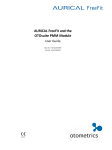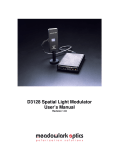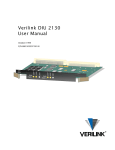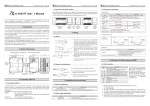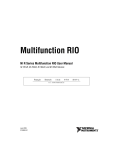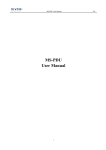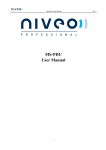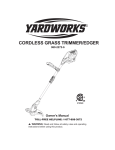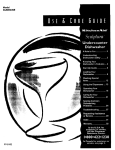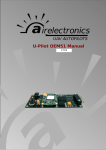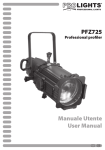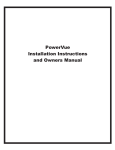Download LX1N Hardware Manual
Transcript
HCFA Corporation Limited HARDWARE MANUAL LX1NSERIES PROGRAMMABLE CONTROLLERS Foreword............................................................................................................................. 3 1. Introduction .................................................................................................................... 6 1.1 Rules of Expansion.......................................................................................................... 7 1.2 Back up Data ....................................................................................................................7 1.2.1 EEPROM backup ................................................................................................. 7 1.2.2 Capacitor backup .................................................................................................. 7 1.2.3 Initialize Latched (Keep) Devices .............................................................................. 8 2. Installation Notes ........................................................................................................... 9 2.1 Product Outline ................................................................................................................9 2.2 LX1NRUN/STOP Control..............................................................................................10 2.3 General Specifications .................................................................................................. 11 2.4 PLC Mounting Arrangements .......................................................................................11 2.5 DIN Rail Mounting.......................................................................................................... 12 2.6 Direct Mounting .............................................................................................................. 13 2.7 Wiring...............................................................................................................................13 2.7.1 Termination at Screw Terminals ....................................................................... 13 2.7.2 Removal and installation of quick-release terminal block ............................14 2.8 Installing Optional Units ................................................................................................14 2.8.1 Expansion Boards ..............................................................................................14 3. Power Supply ............................................................................................................... 15 3.1 Wiring Techniques ......................................................................................................... 15 3.2 Wiring Cautions .............................................................................................................. 16 3.3 Power Supply .................................................................................................................16 3.4 Power Requirements..................................................................................................... 16 3.5 Example Wiring .............................................................................................................. 17 3.5.1 AC Power supply ................................................................................................17 3.5.2 24V DC Power supply........................................................................................18 3.5.3 12V DC Power Supply .......................................................................................19 3.6 Service Power supply.................................................................................................... 19 3.7 Earthing / Grounding ..................................................................................................... 19 4. Inputs ............................................................................................................................ 20 4.1 24V DC input Specifications.........................................................................................20 4.1.1 Typical Wiring ...................................................................................................... 20 4.1.2 Input Circuit Connection ....................................................................................21 4.1.3 Diodes and Inputs Connected in Series..........................................................21 4.1.4 Resistors and Inputs Connected in Parallel ...................................................21 1 HCFA Corporation Limited 4.2 AC110V Input Extension Block ....................................................................................22 5. Outputs ......................................................................................................................... 22 5.1 Output Specifications .................................................................................................... 22 5.2 Relay Output Example .................................................................................................. 22 5.2.1 Product life of relay contacts ............................................................................. 23 5.2.2 Output circuit configuration ............................................................................... 24 5.3 Transistor Output Example ...........................................................................................25 5.3.1 Transistor Output Writing Diagram (Source Type)......................................... 25 5.3.2 Japanese Model Transistor Output (Sink Type) ............................................. 26 5.3.3 Response Times ................................................................................................. 26 5.3.4 External wiring precaution .................................................................................26 6. Diagnostics................................................................................................................... 27 6.1 Preliminary Checks........................................................................................................ 27 6.2 ERROR LED ON (CPU ERROR) ................................................................................27 6.3 Common Errors.............................................................................................................. 28 6.4 Maintenance ...................................................................................................................28 6.5 Operation and Error Flags ............................................................................................28 6.6 PLC Status Registers ................................................................................................. 29 6.7 Error Registers ............................................................................................................... 29 6.8 Error Codes ....................................................................................................................30 6.9 Instruction List ................................................................................................................30 6.10 Device List ....................................................................................................................31 2 HCFA Corporation Limited Foreword • This manual contains text, diagrams and explanations which will guide the reader in the correct installation and operation of the LX1N Series Programmable Controllers. It should be read and understood before attempting to install or use the unit. • If in doubt at any stage of the installation of an LX1NSeries Programmable Controller always consult a professional electrical engineer who is qualified and trained to the local and national standards which apply to the installation site. • If in doubt about the operation or use of LX1NSeries Programmable Controller please consult the nearest Mitsubishi Electric distributor. • This manual is subject to change without notice. LX1N SERIES PROGRAMMING CAUTION Thank you for buying The HCFALX1N series controller. Please note the following. Notes: Block Move instruction Applicable PLC: LX1NVer 1.00-2.10 Applicable instructions: BMOV, BMOVP(FNC15) If the file register parameter setting and the registers D8000-D8225 are used as the destination devices for the BMOV (BMOVP) instruction, program steps or file register data may be lost or damaged. All other data registers can be used safely for BMOV(BMOVP) instruction destination registers. Program example Guidelines for the safety of the user and protection of the LX1N. This manual provides information for the installation and use of the LX1N. The manual has been written to be used by trained and competent personnel. The definition of such a person or persons is as follows; a) Any engineer who is responsible for the planning, design and construction of automatic equipment using the product associated with this manual should be of a competent nature, (trained and qualified to the local and national standards required to fulfill that role). These engineers should be fully aware of all aspects of safety with regards to automated equipment. b) Any commissioning or service engineer must be of a competent nature, trained and qualified to the local and national standards required to fulfill that job. These engineers should also be trained in the use and maintenance of the completed product. This includes being completely familiar with all associated documentation for the said product. All maintenance should be carried out in accordance with established safety practices. c) All operators of the completed equipment (see Note) should be trained to use that 3 HCFA Corporation Limited product in a safe manner in compliance to established safety practices. The operators should also be familiar with documentation which is associated with the operation of the completed equipment. Note :The term ‘completed equipment’ refers to a third party constructed device which contains or uses the product associated with this manual. Note’s on the symbols used in this manual At various times throughout this manual certain symbols will be used to highlight points of information which are intended to ensure the users’ personal safety and protect the integrity of the equipment. Whenever any of the following symbols are encountered, its associated note must be read and understood. Each of the symbols used will now be listed with a brief description of its meaning. Hardware warnings 1) Indicates that the identified danger WILL cause physical and property damage. 2) Indicates that the identified danger could POSSIBLY cause physical and property damage. 3) Indicates a point of further interest or further explanation. Software warning 1) Indicates special care must be taken when using this element of software. 2) Indicates a special point which the user of the associate software element should be aware of. 3) Indicates a point of interest or further explanation. • Under no circumstances will Mitsubishi Electric be liable or responsible for any consequential damage that may arise as a result of the installation or use of this equipment. • All examples and diagrams shown in this manual are intended only as an aid to understanding the text, not to guarantee operation. Mitsubishi Electric will accept no responsibility for actual use of the product based on these illustrative examples. • Please contact a Mitsubishi Electric distributor for more information concerning applications in life critical situations or high reliability. Note Concerning the CE Marking This document does not guarantee that a mechanical system including this product will comply with the following standards. Compliance to EMC directive and LVD directive of the entire mechanical system should be checked by the user / manufacturer. 4 HCFA Corporation Limited For more details please contact the local Mitsubishi Electric sales site. Programmable logic controllers are open-type devices that must be installed and used within conductive control boxes. Please use the LX1NSeries programmable logic controllers while installed in conductive shielded control boxes. Please secure the control box lid to the control box (for conduction). Installation within a control box greatly affects the safety of the system and aids in shielding noise from the programmable logic controller. 5 HCFA Corporation Limited 1. Introduction This manual covers hardware installation instructions for the LX1NSeries PLC. Table 1.1: LX1NMain Unit Function Expansion Board Communication blocks RS_232C block Special function blocks RS_485 block RS_422 block Analogue input/output block 4 points input & 2 points output block LX1N Basic Units AC Power Supply DC Power Supply DC INPUT Relay output Transistor output Points L(mm) W(mm) H(mm) LX1N-24MR(T)(24 points) 130.2 90 81 LX1N-40MR(T)(40 points) 182.2 90 83 LX1N-60MR(T)(60 points) 220.2 90 83 Table 1.1: Powered Extension Blocks ■Input ■Output Input & output ■Special Expansion Expansion Positioning Expansion expansion Block/Analog Unit Block Block TX2N-8EX TX2N-16EX TX2N-8EYR TX2N-8EYT TX2N-16EYR TX2N-16EYT Analogue block Control block block A/D TX2N-2AD TX2N-4AD TX2N-8AD D/A TX2N-2DA TX2N-4DA 6 TX2N-8ER TX2N-16ER TX2N-8ET TX2N-1PG TX2N-4PG TX2N-10PG TX2N-1RM-SET TX2N-10GM TX2N-20GM TX0N-3A TX2N-4AD-4DA TX2N-4AD-2DA TX2N-4AD-TC TX2N-4AD-PT TX2N-2LC TX2N-1HC HCFA Corporation Limited 1.1 Rules of Expansion The maximum I/O for an LX1Nsystem is 128 I/O points and 8 special function blocks. The LX1NSeries can be expanded as follows when used independently. - 2 special function blocks - 1 special function block and up to 16 I/O points - Up to 32 I/O points An AC powered LX1Ncan be expanded by 8 special function blocks when used in conjunction with an HCA5extension unit (2+6). • If a DC powered main unit is used with a power supply of less than 24VDC -15% (20.4V DC or less), then it cannot be fully expanded by using special function blocks or powered extension units. It can accommodate a maximum of an additional 32 I/O points. • If an LX1Nexpansion board is being used, it does not alter the rules of expansion outlined above, as it utilizes special M coils for its operation and therefore does not contribute to the maximum 128 I/O point count. Only one special function board can be used at any time. See section 3.8 for more details. 1.2 Back up Data 1.2.1 EEPROM backup Data includes the Program, Comment, File Registers (D1000 ~ D7999), and parameter data. This will be stored as long as the EEPROM is not damaged. Mitsubishi Electric has guaranteed a life cycle time of 10,000 writes to the EEPROM memory. Users may experience operational writes to the EEPROM in excess of 10,000; however, due to temperature effects a quantitative estimation cannot be given. When saving the device status in the EEPROM, the electric power of the PLC's built-in capacitor is used. If the PLC has been powered on for five minutes or more, the following device data will be saved in the EEPROM at power down: S0 ~ S127, M384 ~ M511, C16 ~ C31, C235 ~C255, and D128 ~ D255. When the EEPROM keep device status cannot be correctly saved to the EEPROM by shortage of electric charge, at the next power-on the status of the device will be that which saved to the EEPROM at the last save. 1.2.2 Capacitor backup The capacitor backed memory includes M512 ~ M1535, S128 ~ S999, T246 ~ T255, C32 ~ C199, C220 ~ C234, D256 ~ D7999 and the RTC. The capacitor backed memory will retain data for a maximum of 10 days (Ambient 7 HCFA Corporation Limited temperature: 25 °C), and requires 30 minutes to recharge upon power up. Note: The LX1Ndoes not have battery backup, if a system requires backup of more than 10 days (Ambient temperature: 25 °C), a peripheral backup power source must be provided. 1.2.3 Initialize Latched (Keep) Devices • When using non-latched devices To use the latched devices as the non-latched devices, reset the latched devices by an initial pulse (M8002) in program. • When using capacitor latched (keep) devices If the voltage of a capacitor drops, the capacitor keep device status may be stored incorrectly. Therefore, when using the PLC after it has been powered off for more than 10 days (Ambient temperature: 25 °C), re-set up the required devices and the current time after initializing capacitor latched (keep) devices before selecting RUN. Initialization method Latched (keep) devices can be initialized in the PLC memory by using peripheral equipment, and the special auxiliary relay M8032, or executing the ZRST instruction. The two major methods are described below. • Latch memory all clear by special auxiliary relay (M8032) When M8032 is turned ON, all latched (keep) devices (including reset coils of timers and counters) are cleared. M8032 can be turned ON and OFF using the forced ON/OFF operation from peripheral equipment or within the sequence program. Note that latched devices cannot be turned ON while M8032 is ON. When turning ON M8032 within the sequence program, note that latched devices are cleared during END processing after M8032 is turned ON. Program example: This program clears all latched devices. • Reset of device by ZRST (zone reset) instruction The ZRST instruction can clear multiple devices at once. (Because a limited device range can be specified for the ZRST instruction, only part of the latched (keep) devices can be cleared at a time.) 8 HCFA Corporation Limited However, initialization method by the ZRST instruction for capacitor backed timer and counter devices (T246 ~ T255, C32 ~ C199, C220 ~ C234) does not reset the associated coil devices. In order to initialize the associated coil devices, execute the RST instruction for the coil devices being used in the user program as shown in the example program on the left. 2. Installation Notes The installation of LX1Nproducts has been designed to be safe and easy. When the products associated with this manual are used as a system or individually, they must be installed in a suitable enclosure. The enclosure should be selected and installed in accordance to the local and national standards. 2.1 Product Outline Figure 2.1:Features of the LX1N PLC ①Status indicator POWER LED: power-up state RUN LED: running lights ERROR LED: When program error, indicating lamp twinkles When CPU error, indicating lamp lights ②Input indicator: LX1N is octal. 9 HCFA Corporation Limited ③Output indicator: LX1N is octal. ④RS422&485 communication port: Operating according to arrow direction ⑤RS422 communication port: Operating according to arrow direction ⑥RUN/STOP switch ⑦Terminal cover ⑧The right expansion cover ⑨The front cover, built-in battery interface ⑨Two analog potentiometer opening 2.2 LX1NRUN/STOP Control RUN or STOP of the LX1Ncan be controlled by: ①The RUN/STOP switch mounted next to the programming port. ②A standard input (X0 to X17) defined by the system parameters. ③Remotely from a personal computer or other programming peripheral Note: The LX1NRUN/STOP switch works in parallel with the RUN-input terminal. Please refer to the table below. During remote operation the LX1NRUN/STOP status is determined by the most recently operated control. E.g. If the RUN/STOP switch is in RUN and a remote STOP is made from a personal computer the RUN/STOP switch must be switched to STOP then back to RUN to switch the MPU back to RUN mode Figure 2.2:RUN input terminal Table : RUN/STOP selection 10 HCFA Corporation Limited 2.3 General Specifications Power supply Item Power supply Power consumption In-rush current Power supply(DC24V) Input Spec. Output Spec. I/O & Special function expansion Performance Program memory Time function Instruction Cycle time per log. Instruction High speed processing Max integrated I/O point Auxiliary relay& timers Counter Others Data registers Analog potentiometer Internal communication interface communication Specification AC POWERED MODULE:100~240V AC DC POWERED MODULE:DC24V AC POWERED MODULE:30W(24M),32W(40M),35W(60M) DC POWERED MODULE:15W(24M),18W(40M),20W(60M) AC POWERED MODULE:30A (max.)/5ms(at AC100V),50A/5ms(at AC200V) DC POWERED MODULE:25A(max.)/1ms(at DC24V), 22A/0.3ms(at DC12V) AC POWERED MODULE:DC24V 400mA DC24V 7mA/5mA Relay output:2A/1 point,8A/4points COM ≤AC250V, ≤DC30V Transistor output:0.5A/1 point,0.8A/4 points COM DC5V~30V Increase digital or analogue I/O points with expansion board 8,000 steps of built-in program memory (EEPROM),no battery Transmit storage box available Integrated real-time clock Standard:27 step ladder:2 special function:89 Standard:0.5~0.7μs special:3.7~hundreds μs I/O refresh instruction is available 134 points Auxiliary relay:1,536 points timer:256 points General:200 points(16 bit) 35 points(32 bit) High speed counters: (1 phase)60KHz/2 points,10KHz/4 points(2 phase),30KHz/1 point,5KHz/1point General:8,000 points,Index:16 points,File:7,000 points(max.) Built-in 2 points RS422 RS-232C,RS-485,RS-422,N:Nnet,parallel link, PC communication 2.4 PLC Mounting Arrangements To prevent a rise in temperature, mount the units to walls. Never mount them to the floor or ceiling of an enclosure. Below (left) Single row arrangement Caution • Units should not be installed in areas subject to the following conditions: excessive or conductive dust, corrosive gas (salt air, Cl2, H2S, SO2, NO2, etc.) or flammable gas, 11 HCFA Corporation Limited moisture or rain, excessive heat, regular impact shocks or excessive vibration. • Take special care not to allow debris to fall inside the unit during installation e.g. cut wires, shavings etc. Once installation is complete remove the protective paper band, to prevent overheating. • Always ensure that mounted units and blocks are kept as far away as possible from high-voltage cables, high-voltage equipment and power equipment. • Do not lay signal cables near high voltage power cabling or cabinet housing along the same trunking duct. Effects of noise or surge induction may occur. Keep signal cables of more than 100 mm (3.94") away from these power cables. • Install necessary power supply cut off precautions to the enclosure of the final system. Attach a warning label (hazard symbol 417-IEC-5036) concerning electric shock to the enclosure. •Use the LX1Nseries PLC with consideration for electrical noise in an environment that does not exceed conditions provided by EN50081-2 and EN61000-6-2. • Cut off all phases from the power source before installation or performing wiring work to avoid electric shock. Incorrect operation can lead to serious damage to the product. • Cut off all phases from the power source before installing/removing extension or communication cables to modules to avoid electric shock, incorrect operation or serious damage to the product. • Replace the terminal cover provided, after installation or wiring work is completed, and before supplying power and operating the unit to avoid electric shock. • After reading the manual's safety instructions, initiate the operation for making program changes while the PLC is in RUN mode, forcing ON/OFF and switching RUN/STOP. • The power supply of the extension units/blocks and the special function units/blocks should be started at the same time or earlier than the LX1NSeries main unit. • DO NOT use the “●” terminal in PLC. • When using an incorrect power source or performing incorrect operation, serious damage will occur regardless of the level of the voltage and frequency. • When performing incorrect wiring or operation, serious damage will occur. • The “L” and “N” terminals are not reversible. If the “L” and “N” terminals are reversed, the units/blocks may be seriously damaged. • The “24V” and “0V” terminals are not reversible. If the “24V” and “0V” terminals are reversed, the units/blocks may be seriously damaged. • During transportation avoid any impact as the PLC is a precision instrument. It is necessary to check the operation of PLC after transportation, in case of any impact damage. • When storing the PLC, conform to the environmental conditions specified by the general specification. 2.5 DIN Rail Mounting Units can be snap mounted to 35mm (1.37") DIN rail (DIN 46277). To release, pull the spring loaded clips away from the rail and slide the unit up and off. 12 HCFA Corporation Limited 2.6 Direct Mounting Table :Hole positions UNIT mm inches ± 0.2 ± 0.01 A = W-8mm (0.32") LX1N-24M☆ 2-∅ 82 3.23 LX1N-40M☆ ( →) 122 4.81 167 6.58 LX1N-60M☆ ∅= 4.5mm (0.17") •Make sure toturn OFF the power before installing this product. 2.7 Wiring 2.7.1 Termination at Screw Terminals Terminal screws should be tightened to between 0.5 to 0.8 N‚m. Terminal screws must be secured to prevent a loose connection thus avoiding a malfunction. The terminal screws for the LX1N, HCA5 Series PLCs are M3.0.When installing 1 or 2 crimp terminals to a terminal, see explanation Figure 2.5 and 2.8. However, 3 crimp terminals or more should not be installed to a single terminal. 1) Handle the crimp terminal of the following size when 1 wire is used per terminal. Refer to Figure 2.5 for installation instructions Figure 2.3:Crimp Terminal for M3.5 Screws Figure 2.4:Crimp Terminal for M3 Screws Figure 2.5:Installing 1 wire Per a Terminal 2) Handle the crimp terminal of the following size when 2 wires are used per terminal. 13 HCFA Corporation Limited Refer to Figure 2.8 for installation instructions. Figure 2.6:Crimp Terminal for M3.5 Screws Figure 2.7:Crimp Terminal for M3 Screws Figure 2.8:Installing 2 Wires Per a Terminal Caution: Make sure to turn OFF the power before starting any wiring work. 2.7.2 Removal and installation of quick-release terminal block • Removal : Loosen the left and right screws evenly. • Installation : Tighten the left and right screws evenly. Tightening torque 0.4 to 0.5 N•m Make sure that the center of the terminal block is not lifted 2.8 Installing Optional Units 2.8.1 Expansion Boards The following is a generic explanation of how to install an expansion board on to the 14 HCFA Corporation Limited LX1NPLC. For greater detail, specifications and wiring examples for each optional unit, please see the relevant product manuals. MODEL USE WITH TX1N-EEPROM-8L USE WITH TX1N-BAT TX1N-EEPROM-8L X X TX1N-232-BD Possible for program upload and Standard life of TX1N-BAT: 2 TX1N-422-BD download years TX1N-485-BD while the PLC is in the STOP mode (at ambient temperature of TX1N-4EX2EYT-BD 25 °C (77 °F)) TX1N-2AD-BD For details on installation and TX1N-1DA-BD maintenance, etc., refer to the TX1N-BAT USER'S MANUAL TX1N-BAT X X Always make sure the power is turned off, before installing a special function board. Only oneboard can be used at any one time, do not try to stack multiple boards. A) Special function or optional equipment board. B) Optional equipment connector port. C) M3 screw to secure board. D) Top cover for board. E) M3 screw to secure top cover. Note: Do not remove this screw. • Remove base unit top cover. • Plug board A) into connector B). • Fix board to base unit using screws C). • Attach top cover for board D) removing section D)’ to exposeconnector etc. (if applicable) • Secure top cover with M3 screw E) 3. Power Supply 3.1 Wiring Techniques Wiring for LX1Nproducts has been designed to be safe and easy. If the user is concernedabout the correct installation of these products or associated products, please contact aprofessional electrician who is trained to the local and national standards applicable to theinstallation site. 15 HCFA Corporation Limited 3.2 Wiring Cautions • Do not run input signals in the same multicore cable as output signals or allow them toshare the same wire. • Do not lay I/O signal cables next to power cables or allow them to share the same trunkingduct. Low voltage cables should be reliably separated or insulated with regard to highvoltage cabling. • Where I/O signal lines are used over an extended distance consideration for voltage dropand noise interference should be made. 3.3 Power Supply • When wiring an AC supply, the “Live” cable should be connected to the “L” terminal and the “Neutral” cable should be connected to the “N” terminal. Do NOT connect the “Live” wire tothe “N” terminal, otherwise, the user may receive a dangerous shock upon powerup. • When wiring a DC supply the “Live” cable should be connected to the “+” terminal and the “Neutral” cable should be connected to the “-” terminal. Do NOT connect the “Live” wire tothe “-” terminal, otherwise, the user may receive a dangerous shock upon powerup. • When using a DC power supply type, it is the power source for an input extension blockbetween "24V" and "0V" terminals. Never supply an external power supply to these terminals. Moreover, do not connect any equipment exceptan extension block to these terminals. • Never connect the "0V" and the "-" terminals of a DC power supply type main unit. 3.4 Power Requirements *1 Includes the input current(5 or 7mA per point). *1 Includes the input current (5 or 7mA per point). Table 4.1 :AC Power Supply Units LX1N-24MR(T) LX1N-40MR(T) Power supply 100 - 240V AC +10%, -15%, 50-60Hz Max. allowable 10ms; if less than 10ms, the PLC will continue operation. momentary If 10ms or more, the PLC will shut down power failure period Fuse (size) rating 250V 1A 250V 3.15A (3A) 16 LX1N-64MR(T) HCFA Corporation Limited In-rush current 100V AC - Max. 30A for 5ms 200V AC - Max. 50A for 5ms 30W*1 Power 32W*1 35W*1 consumption 400 mA 24V DC Service Supply *1 Includes the input current(5 or 7mA per point. Table 4.2 :DC Power Supply Units LX1N-24MR(T) LX1N-40MR(T) Power supply 12 - 24V DC +20%, -15% (10.2 - 28.8V DC) Max. allowable 5 ms; If less than 5 ms, the PLC will continue operation. momentary If 5 ms or more, the PLC will shut down LX1N-64MR(T) power failure period Fuse (size) rating 125 V 3.15A In-rush current 24V DC - Max. 25A for 1ms 12V DC - Max. 22A for 0.3ms Power 15W 18W 20W consumption*1 *1 Includes the input current (5 or 7mA per point). 3.5 Example Wiring 3.5.1 AC Power supply *1 It is recommended to use the same power source to power the main unit, poweredextension units and special function blocks/units. If two sources are required, follow thebelow guidelines: - Supply power to the powered extension units and special function blocks/units beforeor at the same time the main unit is powered. - The power supplies may be cut the same time after ensuring system safety. 17 HCFA Corporation Limited 3.5.2 24V DC Power supply *1 It is recommended to use the same power source to power the main unit, poweredextension units and special function blocks/units. If two sources are required, follow thebelow guidelines: - Supply power to the powered extension units and special function blocks/units beforeor at the same time the main unit is powered. - The power supplies may be cut the same time after ensuring system safety. *2 Never connect the "0V" and the "-" terminals of a DC power supply type main unit. *3 When using a DC power supply type, it is the power source for an input extension blockbetween "24V" and "0V" terminals. Never supply an external power supply to these terminals. Moreover, do not connect any equipment except an extension block to these terminals. 18 HCFA Corporation Limited 3.5.3 12V DC Power Supply *1 Never connect the "0V" and the "-" terminals of a DC power supply type main unit. *2 When using a DC power supply type, it is the power source for an input extension blockbetween "24V" and "0V" terminals. Never supply an external power supply to these terminals. Moreover, do not connect any equipment except an extension block to these terminals. 3.6 Service Power supply An AC powered LX1Ncan supply a service current of 24V DC at 400mA when used on its ownand, when used with extension or special function blocks. A DC powered LX1Ndoes not have the capacity to supply a service current. HoweverAdditional extension blocks can be powered from the main units power supply. 3.7 Earthing / Grounding Use a cable at least 0.2mm2(AWG24) to ground equipment. Ground resistance must beless than 100Ω. Note that the ground cable must not be connected to the same ground as the power circuits. 19 HCFA Corporation Limited 4. Inputs 4.1 24V DC input Specifications LX1Nmain unit,extension block X0 →X7 X10 →∞ Input voltage 24V DC ±10% Input current 24V DC, 7mA 24V DC, 5mA >3.5mA Input switching OFF →ON >4.5mA current ON →OFF <1.5mA Response time 10ms Variable response time X000-X007 0-15ms Circuit isolation Photocoupler Operation indication LED is lit - 4.1.1 Typical Wiring Note: The input circuit power supply provides a clean+24VDC supply for the inputs. Hence use an external+24VDC power supply at your own risk. The input circuit power supply cannot provide aservice supply to special function blocks (SFB). Usean external supply to power the SFBs. When using an AC powered unit, an external 24V DCsupply can be used. *1 When using a DC power supply type, it is the power source for an input extension blockbetween "24V" and "0V" terminals. Never supply an external power supply to these terminals. Moreover, do not connect any equipment except an extension block to these terminals. *2 Never connect the "0V" and the "-" terminals of a DC power supply type main unit. 20 HCFA Corporation Limited 4.1.2 Input Circuit Connection LX1NMain Units 4.1.3 Diodes and Inputs Connected in Series Vdrop across the diode Max. 4V No more than 2 LEDs should be connected in series. 4.1.4 Resistors and Inputs Connected in Parallel Parallel resistance Rp: LX1N= 15kΩ. If resistance Rp is less than the stated value, then add Rb. See equation 1 for Rb calculation. Alternatively; Current leakage: LX1N= 1.5mA. If the current leakage is greater than the stated value, then add Rb. See equation 2 for Rb calculation. Parallel LED 21 HCFA Corporation Limited 4.2 AC110V Input Extension Block 5. Outputs 5.1 Output Specifications 5.2 Relay Output Example Typical Relay 22 HCFA Corporation Limited 5.2.1 Product life of relay contacts The product life of relay contacts considerably varies depending on the load type used. Take care that loads generating reverse electromotive force or rush current may cause poor contact or deposition of contacts which may lead to considerable reduction of the contact product life. 1) Inductive load Inductive loads generate large reverse electromotive force between contacts at shutdown may cause arcing. At a fixed current consumption, as the power factor (phase between current and voltage) gets smaller, the arc energy gets larger. The test results in table 6.1 were gathered from a 1 sec ON/OFF test cycle. Please note that the over current induced by in-rush greatly reduces the relay contacts life. The rated life for an inductive AC load such as a contactor or solenoid valve is 500,000 operations at 20VA. Table 6.1: The product life of relay contacts becomes considerably shorter than the above conditions when the rush overcurrent is shut down. * For countermeasures while using inductive loads, refer to "Output circuit configuration" below in this section. Some types of inductive loads generate rush current 5 to 15 times the stationary current at activation. Make sure that the rush current does not exceed the current corresponding to the maximum specified resistance load. 2) Lamp load Lamp loads generally generate rush current 10 to 15 times the stationary current. Make sure that the rush current does not exceed the current corresponding to the maximum specified resistance load. 3) Capacitive load Capacitive loads can generate rush current20 to 40 times the stationary current. Make sure that the rush current does not exceed the current corresponding to the maximum specified resistance load. Capacitive loads such as capacitors may be present 23 HCFA Corporation Limited in electronic circuit loads including inverters. * For the maximum specified resistance load, refer to Section 6.1. 5.2.2 Output circuit configuration An internal protection circuit for the relays is not provided in the relay output circuit for this product. It is recommended to use inductive loads with built-in protection circuits. When using loads without built-in protection circuits, insert an external contact protection circuit, etc. to reduce noise and extend the product life. 1) DC load Connect a diode in parallel with the load. The diode (for commutation) must comply with the following specifications. 2) AC load Connect the surge absorber shown to the right (combined CR components such as a surge killer and spark killer, etc.) parallel to the load. Select the rated voltage of the surge absorber suitable to the output used. Refer to the table below for other specifications. 3) Interlock For loads such as forward/reverse contactors, etc., where a hazardous condition could result if switched ON simultaneously, an external interlock should be provided for interlocking the PLC's internal programs as shown to the right. 24 HCFA Corporation Limited 4) In-phase PLC output contacts (*) should be used in an "in-phase" manner. 5.3 Transistor Output Example 5.3.1 Transistor Output Writing Diagram (Source Type) 25 HCFA Corporation Limited 5.3.2 Japanese Model Transistor Output (Sink Type) 5.3.3 Response Times OFF times increase as the load current decreases. For improved response times use a ‘dummy’ resistor, see the figure below. If a response time of 0.5 ms or better is required when using ‘light loads’ use a ‘dummy’ resistor and ensure the signal line has a current greater than 60mA/24V DC Y000 and Y001 are high speed response outputs with the following characteristics: 10 - 100mA at 5 - 24V DC, 100kHz maximum output signal. If a high speed response is required, a current of 10 - 100mA must be used. 5.3.4 External wiring precaution 1) Contact protection circuit for inductive loads Transistor outputs use internal zener diode (50V) as protection circuitry. When driving the inductive load with transistor output, a reverse-current protection diode can be installed in parallel with the load if necessary. The reverse-current protection diode needs to satisfy the following specifications. - Choose a commutating diode that has a reverse voltage strength over 5 - 10 times the load voltage, and a forward current over the load current. 26 HCFA Corporation Limited 2) Mechanical Interlock Ensure all loads are applied to the same side of each PLC output, see previous figures. Loads which should NEVER simultaneously operate (e.g. direction control of a motor), because of a critical safety situation, should not rely on the PLC’s sequencing alone. Mechanical interlocks MUST be fitted to all critical safety circuits. (See proceeding figure.) 6. Diagnostics 6.1 Preliminary Checks 6.2 ERROR LED ON (CPU ERROR) 27 HCFA Corporation Limited 6.3 Common Errors - Corroded contact points at some point in an I/O line. - An I/O device has been used outside its specified operating range. - An input signal occurs in a shorter time period that taken by one program scan. 6.4 Maintenance - Check interior temperature of the panel. - Check panel air filters if fitted. - Check for loosening of terminals or mounting facilities (due to vibration) 6.5 Operation and Error Flags 28 HCFA Corporation Limited 6.6 PLC Status Registers 6.7 Error Registers 29 HCFA Corporation Limited 6.8 Error Codes 6.9 Instruction List 30 HCFA Corporation Limited 6.10 Device List Item Program capacity Specification 8k steps Remarks Provided by built in EEPROM memory I/O configuration Max hardware I/O configuration points 128, dependent on user selection (Max. software addressable Inputs 128, Outputs 128) Auxiliary relay General 384 points M0 to M383 (M coils) Latched 1152 points M384 to M1535 (EEPROM EEPROM keep: 128 points EEPROM keep: M384 to M511 backed-up) Capacitor keep: 1024 points Capacitor keep: M512 to M1535 Special 256 points From the range M8000 to M8255 State relays Latched 1000 points S0 to S999 (S coils) (EEPROM EEPROM keep: 128 points EEPROM keep: S0 to S127 backed-up) Capacitor keep: 872 points Capacitor keep: S128 to S999 Initial 10 points (subset) S0 to S9 100 msec 200 points T0 to T199 Timers () Range: 0 to 3,276.7 sec 10 msec 46 points T200 to T245 31 HCFA Corporation Limited Range: 0 to 327.67 sec Counters (C) 1 msec 4 point, Capacitor keep retentive Range: 0 to 32.767 sec 100 msec 6 points, Capacitor keep retentive Range: 0 to 3,276.7 sec General 16 points C0 to C15 Range: 1 to 32,767 counts Type: 16 bit up counter Latched 184 points C16 to C199 (EEPROM Range: 1 to 32,767 counts EEPROM keep: C16 to C31 backed-up) EEPROM keep: 16 points Capacitor keep: C32 to C199 Capacitor keep: 168 points Type: 16 bit up counter 20 points C200 to C219 Range: -2,147,483,648 to Type: 32 bit bi-directional counter General T246 to T249 T250 to T255 2,147,483,647 counts Latched 15 points, Capacitor keep C220 to C234 (EEPROM Range: -2,147,483,648 to Type: 32 bit bi-directional counter backed-up) 2,147,483,647 counts High speed 1 phase Range: -2,147,483,648 to C235 to C240, 6 points counters (C) 1 phase +2,147,483,647 counts C241to C245, 5 points Max. 6 points c/w start General rule: Select counter stop input combinations with a combined 2 phase counting frequency of 60kHz or C246 to C250, 5 points A/B phase less. C251 to C255, 5 points Note; all counters are latched (EEPROM backed-up) If high speed counter is used with the HSCS or instruction, a counting frequency HSCR combined of 30kHz or less Data General 128 points D0 to D127 registers (D) Type: 16 bit data storage register pair for 32 bit device Latched 7872 points D128 to D7999 (EEPROM EEPROM keep: 128 points EEPROM keep: D128 to D255 backed-up) Capacitor keep: 7744 points Capacitor keep: D256 to D7999 Type: 16 bit data storage register pair for 32 bit device File Maximum 7000 points D1000 to D7999 set by parameter in 14 blocks of 500 program steps Type: 16 bit data storage register 32 HCFA Corporation Limited Externally 2 points D8030 & D8031 adjusted Range: 0 to 255 Data is entered indirectly through the external setting potentiometer Special 256 points (inclusive From the range D8000 to D8255 of D8030 and Type: 16 bit data storage register D8031) Index 16 points V and Z Type: 16 bit data storage register Pointers (P) For use 128 points P0 to P127 6 points I00❏to I50❏ with CALL For use with (rising trigger ❏= 1, interrupts falling trigger ❏= 0) Nest levels 8 points for use with MC and N0 to N7 MCR Constants Decimal K 16 bit: -32,768 to +32,767 32 bit: -2,147,483,648 to +2,147,483,647 Hexadecimal 16 bit: 0000 to FFFF H 32 bit: 00000000 to FFFFFFFF 33





































